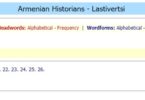Vartanants Day Speech
St. Gregory the Illuminator Church
Philadelphia, March 5, 1984
Tom Samuelian
Today I would like to ask and try to answer a question which, for me and many of you, is probably more than rhetorical.
That is, why after 1533 years do we, or should we, remember, the heroic, but disastrous last stand of Vartan Mamikonian and the 1036 soldiers who fell by his side at Avarayr in 451 AD?
In the short term, it was not a particularly successful the battle. During the ensuing 25 years, the Persian overlords intensified their propagation of Zorastrianism, social and political oppression grew, the Catholicos Hovsep and the priest Ghevond were executed, the Armenian nobles were systematically dispossessed of their hereditary estates, and the people had been driven off their lands and forced to take refuge in the forests and mountains. Indeed, in the following decade, few would have looked upon 451 as a date to remember and celebrate even as some sort of moral victory. Perhaps it was a date which evoked commemoration, national mourning, or a day for exhortation, although even that is not clear. What is clear is that something happened in the course of the following 1500 years to make it significant and worth not merely commemorating, but celebrating.
The single most important event that might have changed the military disaster into a moral victory, is the less well-known rebellion led by Vartan’s nephew, Vahan Mamikonian. The rebellion led to the Treaty of Nvarsag in 484 AD which, as you will have already calculated, was signed exactly 1500 years ago this year. Before I turn to the Treaty and the events which transpired between the Battle of Avarayr and the Peace of Nvarasag, we should pause to give Vartan his due.
For in a sense, it was during this period that the phenomenon of Vartanants matured into the symbol we recognize today, and it was the outcome of this later rebellion which assured Vartanants a place in the constellation of Armenian national symbols. Vartan died in defense of one of the central and primary cultural institutions of the Armenian people, and it is not, therefore, surprising that an officer of that institution, namely the vardapet Yeghishe, should have found Vartan’s story a suitable subject for his history. This history, which has been translated into English at least twice in the past 50 years, was of the didactic sort, aimed at cultivating the people’s moral national and religious fidelity and devotion. Without entering into the controversies surrounding the authenticity of authorship, it is fair to say that Yeghishe is single handedly responsible for articulating and image and creed which has spoken to the hearts and minds of the Armenian people ever since.
Tradition tells us that Vartan died for his beliefs and in defense of the Christian faith. As such he is at once an example of the ideal that there are things worth fighting for and a symbol of loyalty to ideals. That symbol has served both as an inspiration for emulation and a reason to act, without fear and with resolve, on our beliefs.
The history of no people takes place in isolation and the history of the Armenians, particularly this episode is as much an outcome of forces beyond the Armenians’ control as of any special heroism or valor on their part. The fate of the Armenians depended largely on the balance among the great powers of the time: Rome, Byzantium and Persia. It is well to remember that the fifth century was a period of great migrations emanating from Central Asia crossing Eastern and Western Europe. One part of the migration reached England where the Angles and Saxons were just settling. In 451 Rome fell, having been overrun by Atilla the Hun. The Goths and Huns were a menace to Byzantium, and the Hephathalites of White Huns (Kushan in Armenian) were attacking Persia on its eastern front.
Armenia was caught in the middle of two empires: It was on the eastern frontier of the Greco-Roman Empire, with its capital in Byzantium, and the Western frontier of Persia, as yet far from the invading hordes. The Armenians were of vital concern to both, but posed no threat to the national security of either empire, except to the extent that each of the Persians and Byzantines perceived a threat from the other. Since both empires were under attack on the frontiers furthest from Armenia, neither could afford to risk a war on a second front. The Armenians played upon this reluctance. The principle diplomatic weapon in the Armenian arsenal was to appeal to their Christian brethren in Byzantium for protection from the Persians – usually to no avail. And the principle military tactic was to retreat across the border into Byzantine territory where the Persians would not risk confrontation with the Byzantines, or vice versa. This is a pattern which has played out, mutatis mutandis, with regularity and predictability throughout Armenian history. So, these are the positions of the principal players. The action begins with the partition of Armenia between the Byzantines and Persia in 387 A. D. roughly a century before the Treaty of Nvarsag.
In the years immediately following the partition, the Armenian Arshakuni dynasty continued to rule, though subject to the Persian crown. In accordance with a 100-year treaty between Persia and Rome, the Armenian nobles were allowed to maintain military forces to defend the country; the Church was permitted to function, and the people were free to profess and practice Christianity, which had been adopted as the state religion only a few generations before. It was a period of great cultural development. St. Mesrop Mashtots created the Armenian alphabet and with St. Sahak led the translation of the Bible and Christian rites into Armenian. National literature and history flourished in what has come to be known as the golden age of Armenian literature.
This period of toleration and progress came to an end with the death of the last Armenian King Ardashes IV in 428 and the ascension of Yazdgerd II to the Persian throne ten years later. Thereafter, Armenia was ruled by Governors, called marzbans, most of whom were Armenian nobles, appointed by the Persian Emperor. Yazdgerd II, who ruled from 438 to 457, practiced Zoroastrian. He ordered all his subject likewise be converted to this religion. In the next half century whole armies were martyred on the fields of battle and whole villages to refuge in the hills, as the Armenian nobles struggled to organize an effective defense of their homeland and church.
Since we have already heard a great deal today in Church about the Battle of Avarayr and St. Vardan, I will not recount the battle in 451 and its outcome, but instead pick up with the aftermath, leading up to the Treaty of Nvarsag in 484.
In the ensuing years the Armenian nobles regrouped and under Vahan Mamikonian, Vartan’s nephew, formed a resistance movement to the growing oppression of Yazdgerd’s successor, Peroz. During the reign of Peroz the clashes became more frequent and costly. Meanwhile, Persia faced invaders on its eastern front. Thus, Peroz’s brother and successor, King Vagharsh (484-489) wished to extricate himself from hostilities with the Armenians and negotiated with Vahan. Vahan, who from the first had been reluctant to pursue the Armenian cause through military defiance of his overlord, took up the offer of peace on the following three conditions:
- Religion Freedom. Armenians are to be free to practice Christianity; all efforts to convert the Armenians to Zorastrianism are to cease, and all Zorastrian priests and altars are to be removed from Armenia.
- Integrity in Government. State offices are to be filled and discharged justly and the nobles are to be restored to their positions of local authority.
- Direct access to the Persia King. Armenian grievances are to be heard and resolved by the King directly, so as to avoid the corruption and false witness which had undermined the Armenian nobles.
These proposals were accepted by the King’s representative, who was encamped at Nvarsag; hence, the agreement came to be known as the Treaty of Nvarsag. Vahan concluded the treaty in person and amnesty was granted to him and the other rebels. Shortly thereafter, the Persian King, Vagharsh, elevated Vahan to the position of Governor-General. Majestic ceremonies were held at the Cathral of Dvin with the blessing of Catholicos Hovnan Mandakuni. During his twenty years’ rule, Armenian prospered in peace founded on dignity, toleration and freedom.
Over seven hundred years before the Magna Carta, signed by the English King and Nobles in 1215, the Treaty of Nvarsag established, by mutual consent, a law to regulate the relations between king and nobles. After years of struggle, the Persian King Vagharsh concluded that it was better to rule by law and toleration than by force and persecution. In return, the Armenian nobles pledged their loyalty contingent on the just execution of the treaty. Against great odds the small Armenian force under Vahan’s command, had, through their sacrifice and commitment, secured peace with cultural and religious freedom.
Along with the sacrifices of Sts. Vartanants, it is their ideals and commitment to the values of toleration and rule of just laws that we still celebrate and commemorate today after 1500 years.
One should add that the writing of history is always a delicate task. Ghazar Parbetsi, who relates the story of Vahan’s rebellion and the Treaty of Nvarsag, was commissioned by Vahan himself to write the book; they were classmates. To take one instance where considerations beyond those of factual accuracy might have played a part, Vahan is portrayed as a reluctant leader of the rebellion. It is the opinion of several scholars that this portrayal was required in order to reassure Vahan’s Persian overlords that Vahan was fundamentally a loyal subject who had rebelled not against Persian rule, but against intolerable conditions imposed by Peroz the Persian King.
Similarly, we are often prone to attribute the success more to the Armenians’ valor and determination than to the overall shift in the international balance of power, which, of course, was factor beyond Armenian control This shift made appeasement of the Armenians more advantageous than continued hostilities. This is not to underestimate the real agency or ability of Vartan and Vahan and those who fought at their sides, for instance, to have changed the course of Armenian history, but it is reasonable to question whether the Persians, if all were peaceful on their eastern front, would have conceded to the Armenians, whom, given the disparity in size and resources, they could probably, with sufficient determination, have conquered and converted. Nevertheless, this episode shows that while it may not be sufficient to be valorous and true to one’s beliefs, at times, it can yield better results than being docile or compromising or opportunistic. It is a judgment call. To act is to take a risk. As important as probable success is in taking any action, these episodes show that there may be supervening reasons to act: Vahan knew he was right and knew that his present condition was intolerable. The probability of failure or success of any single action must therefore be considered in light of the longer-term consequences, which may have little to do with the short-lived victory or defeat in any single battle. Sometimes success comes with a whimper rather than a roar, as a concession rather than a conquest, as a piece of paper rather than a brandished sword.
The Treaty of Nvarsag is of course merely a piece of paper and no piece of paper ever prevented those who wield power in international affairs from pursing their interest. We can never forget how fragile and rare peacemaking is, something which makes Nvarsag and the century of peace that followed all the more noteworthy.
Why then do we remember Vartanants. Probably because it is a symbol which has been meaningful to our community and nation. Faith sometimes makes martyrs, and martyrs sometimes make faith. Their example spurred Vahan’s generation into successful action and has ever since been a reminder to Armenians of their dignity and rights. Moreover, in a world of fleeting media heroes who come and go with each passing day, there’s a certain amount of pride in being able to remember something noble which we can call our own and which we have been calling our own for 1500 years.







